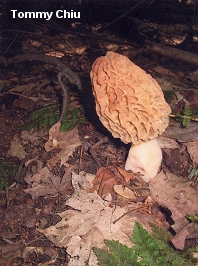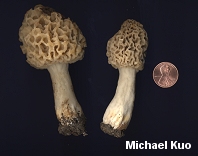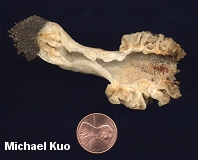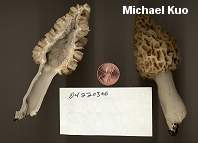| Major Groups > True Morels & Verpas > Morchella cryptica |

|
Morchella cryptica [ Ascomycetes > Pezizales > Morchellaceae > Morchella . . . ] by Michael Kuo Believe me, I tried . . . but I was unable, in my treatment of North American morels (2012), to find any consistent morphological differences between this DNA-defined, Great Lakes-area species and the more widely distributed Morchella esculentoides. The most I was able to say is that Morchella cryptica is often paler than its look-alike, but this is not always the case. And habitat doesn't appear to separate the two species; several times I have found them growing within a few feet of each other, and assumed they were the same species until receiving a DNA result. It may be the case that after many more collections have been made, DNA tested, and studied, features separating the two species will emerge . . . but for now, at least, the differences are cryptic. Cryptic species abound in the fungal world, and they are not very satisfying for folks who are bound and determined to identify every mushroom they find. But they are a phylogenetic reality, and the tempting but ultimately unacceptable alternative to embracing them is to pretend they don't exist. So we are stuck with not knowing, in the Great Lakes region, whether the most commonly collected, consumed, and sought-after morels are Morchella cryptica or Morchella esculentoides without testing their DNA. Morchella esculentoides is the more common species, to judge from DNA testing of specimens contributed to the now closed Morel Data Collection Project, but Morchella cryptica is not uncommon. If this information leads you to identify your morel as Morchella esculentoides based solely on the odds, I can't stop you--but you should be prepared to be wrong when your morel's DNA is examined. Description: Ecology: Possibly saprobic and mycorrhizal at different points in its life cycle; growing alone, scattered, or gregariously under hardwoods, including white ash, green ash, and tulip trees; April, May, and June; in the Great Lakes region from central Illinois to Ontario and western Pennsylvania. Cap: 4-8 cm tall and 3-6 cm wide; egg-shaped with a convex, bluntly conical, or conical apex; pitted and ridged, with the pits randomly arranged and oriented; when young with bald, flattened, pale yellowish ridges and yellowish to grayish yellow pits; when mature with sharpened to eroded, yellow to brownish yellow ridges and similarly colored pits; attached to the stem directly, without a groove; hollow. Stem: 5-13 cm high and 1.5-6 cm wide; usually swollen at the base; whitish; bald or finely mealy with granules; hollow. Microscopic Features: Spores 18-23 x 10-13 (-15) µ; smooth; elliptical; without oil droplets; contents homogeneous. Asci 8-spored. Paraphyses cylindric with variable apices; septate; hyaline to brownish in KOH. Elements on sterile ridges 75-175 x 10-30 µ; septate; hyaline in KOH; terminal cell widely cylindrical with a rounded, subcapitate, capitate, subclavate, clavate, or widely subfusiform apex. REFERENCES: M. Kuo & J. D. Moore in Kuo et al., 2012. (Kuo, 2005; O'Donnell et al., 2011; Kuo et al., 2012.) SPECIMENS EXAMINED: Herb. F. 06020201, 04170302, 04220306, 05100303, 05150303, 05220302, 05240301, 06070302, 06090301, 06090302, 04220401 (holotype), 05090404, 05210403. This site contains no information about the edibility or toxicity of mushrooms. |
© MushroomExpert.Com |
|
Cite this page as: Kuo, M. (2012, November). Morchella cryptica. Retrieved from the MushroomExpert.Com Web site: http://www.mushroomexpert.com/morchella_cryptica.html. |



